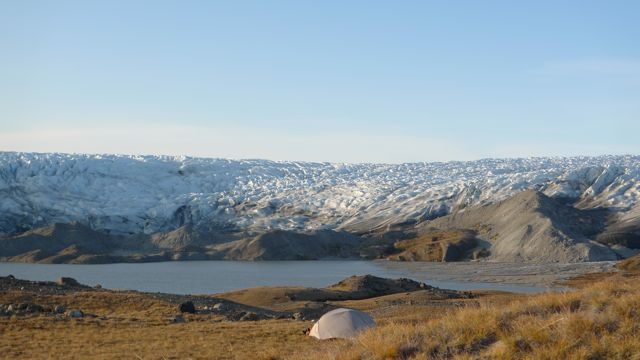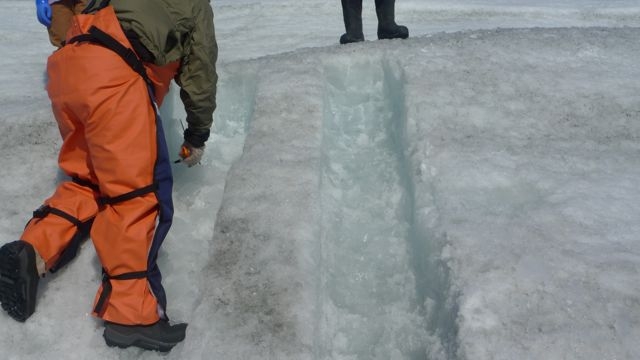
Margin Ice Sampling and the Cause of the Younger Dryas
Greenland 2009
Greenland Margin Ice sampling and the Cause of the Younger Dryas
What caused the Younger Dryas, a period of dramatic climate change that coincided with the extinction of many large North American land mammals and a shift in Paleo-Indian culture? In 2008 Climate Change Institute scientists Paul Mayewski, Andrei Kurbatov and Jørgen Peder Steffensen from Niels Bohr Institute were accompanied by a Nova television film crew to Greenland to investigate one theory.
The hypothesis stated that one or more extraterrestrial bodies (possibly a comet) impacted earth, caused the mass extinction of wooly mammoths, sabre toothed tigers, and giant sloths, triggered the climatic cooling, and significantly changed human culture from Clovis to Post-Clovis cultures. If the theory was a viable one, it was thought that extraterrestrial materials possibly could be found in the glacial ice record of Greenland. Extraterrestrial materials were discovered in Greenland ice and the expedition and it’s results are chronicled in the 2009 Nova program “The Last Extinction”.
Although extraterrestrial material was verified and found at that time, the precise geologic timing of the event was obscured by an ambiguous isotopic/temperature proxy sequence recovered from the Greenland ice during that preliminary investigation. In an effort to clarify that ambiguity, in August 2009, Climate Change Institute researchers Paul Mayewski, Douglas “Cap” Introne and Andrei Kurbatov returned to Greenland accompanied by two undergraduate Univ. of Maine Earth Science students, Brittany Gilman and Stephanie Allard.
The group camped at the edge of the Greenland ice cap where the inner parts of the ice sheet are exposed at the surface of the glacier much like a layer cake or a stack of pancakes. The climatic and chemical record of an ice sheet is more easily and quickly sampled in such an area rather than drilling an ice core with a more expensive ice drill and drilling operation. Only a few places on any ice sheet have the correct geological and glaciologic al conditions to allow for such to occur, and Climate Change Institute researchers are at the forefront in learning how to exploit the climatic and chemical record from these types of areas in both Greenland and in Antarctica.
A more detailed and extensive sampling protocol was undertaken during the expedition in an effort to obtain a complete Holocene, Deglacial and Glacial isotope sequence where the Younger Dryas and Bolling-Allerod transition could be put into a more precise temporal context. While sampling the blue ice area for detailed oxygen isotope samples the Univ. of Maine group also collected concomitant samples for iridium and osmium measurements and with colleagues, James Kennett, Douglas Kennent and Gerald Haug for extraterrestrial materials.


